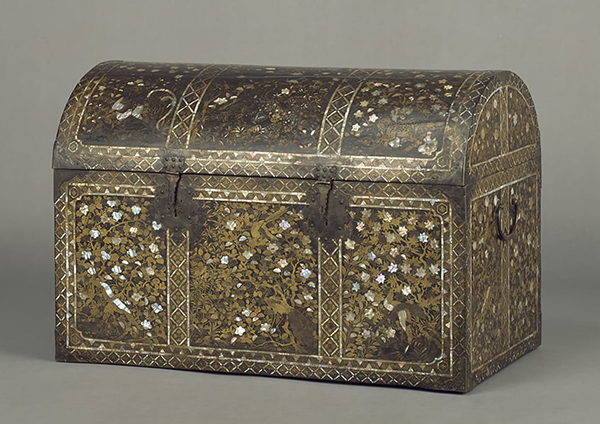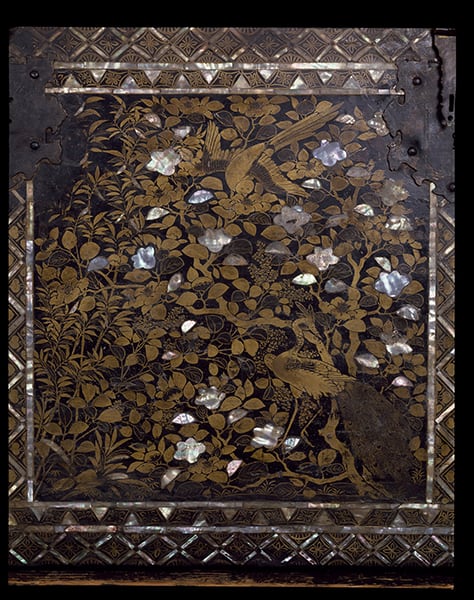- TOP
- Learn
- Learning Resources
- Museum Dictionary
- Lacquerware Stories
- The Story of "Southern-Barbarian Lacquerware"
The Story of "Southern-Barbarian Lacquerware"
Text by Akio Haino, Department of Decorative Arts
English translation by Melissa M. Rinne, Department of Archives
(Issued on January 9, 1993)
The first time Europeans came to Japan was in 1543 (Tenmon 12, by the Japanese calendar). That's when the Portuguese landed on the island of Tanegashima. After that, Europeans began coming to Japan for many different reasons. It was about the same time that two important things were imported from Europe into Japan: rifles and Christianity.
Did you know that rifles were widely used to unify Japan during the Warring Countries Period (1482-1558 A.D.)? It was during that period too that the expansion of Christianity exploded!
The people who came to Japan in order to spread Christianity were missionaries sent by the Roman Catholic church. Have you ever heard of Louis Frois? He was a Portuguese man who studied deeply about Japan and greatly helped the expansion of Christianity. Naturally, he was interested in Japanese art and traditional crafts too. He especially liked the traditional Japanese craft of "maki-e."
Maki-e is a kind of lacquerware. Lacquer is actually the gummy sap of a deciduous tree called Rhu verniciflua (Japanese, urushi), which is related to poison oak and poison sumac. When this sap is painted onto wood, it dries to a shiny, durable and binding finish. To create maki-e decorations, lacquer designs are painted on this surface and sprinkled with gold or other metallic dust. The effect of the gold designs on shiny black lacquer is beautiful! The missionaries liked maki-e so much that they decided to use this technique to make things for their churches. They used maki-e for such things as picture frames for the portraits of Jesus and Mary and for bible stands.
The people who made these maki-e pieces for the missionaries were craftspeople called "maki-e shi" (maki-e lacquer artisans) who lived in Kyoto. They made the pieces according to the instructions they were given and then decorated them with the special maki-e technique. Around the borders of the pieces, they would paint strait or diagonal lines, circles, or other geometric patterns, in accordance with the orders of the missionaries. Within these borders, however, they were free to decorate at will using familiar Japanese-style patterns representing the four seasons, such as flowers, plants and trees.
Not everyone who came to Japan at this time was a missionary. Many traders came to Japan from such countries as Spain and Portugal in order to do business. These people were very interested in buying these rare and beautiful maki-e objects. They thought that they could take them back to Europe and sell them at very high prices. However, in order to sell them to Europeans, the traders had the maki-e craftspeople special-ordered a variety of Western-style objects, such as chests of drawers and decorated boxes. They even had them make coffee cups, although the Japanese did not even drink coffee four-hundred years ago!
At that time, lacquerware inlaid with mother-of-pearl (a technique called raden in Japanese) was not very common in Japan. However, the Spanish and Portuguese thought objects decorated with mother-of-pearl looked very luxurious, so they asked the Japanese craftspeople to incorporate mother-of pearl into their maki-e objects. They knew that they would be able to sell the raden objects at high prices back in Europe.
In Japan, these European-style lacquer objects are known as "Nanban lacquerware." The word Nanban means "southern barbarians," which is what the Japanese of the sixteenth century called Europeans and other foreigners. It might seem strange that the Japanese would call the Europeans "southern barbarians," as Europe is to the west of Japan. The reason for this is that, since ancient times, the Chinese considered foreigners from the south to be uncivilized and barbaric. Over time, the word "southern barbarian" came to mean any foreigner. Much of Japanese culture was imported from China, including the habit of calling all foreigners "southern barbarians."
One of the finest of all the Nanban lacquerware objects is the European-style chest pictured here.

European-style Chest with Plant, Bird, and Animal Designs in Mother-of-Pearl Inlay
(Kyoto National Museum)
Have you ever read the book Treasure Island, the adventure story about the one-legged Captain Silver by Robert Louis Stevenson? The chest into which the pirates put the treasure in this story is the same shape as this "southern barbarian" chest, isn't it.
Now, look more closely at the birds in this chest. In the center panel there is a cute bird with its eyes wide open. I call this bird "the surprised bird."

European-style Chest with Plant, Bird, and Animal Designs in Mother-of-Pearl Inlay (Detail)
(Kyoto National Museum)
Can you see a peacock under "the surprised bird?" In this maki-e panel, the botanical designs all depict Japanese plants, trees, and flowers, but the birds and animals, such as tigers, lions, and this peacock, represent creatures that the craftspeople who made them had never seen before. They were only able to paint them after looking at European pictures. That must have been very difficult.
This luxurious "southern barbarian" lacquerware, so loved by the Europeans, was made only for a period of about fifty years during Japan's Momoyama period (1573-1615). When Japan closed its borders to the outside world in the Edo period (1615-1868), the production of "southern barbarian" lacquerware ended.






